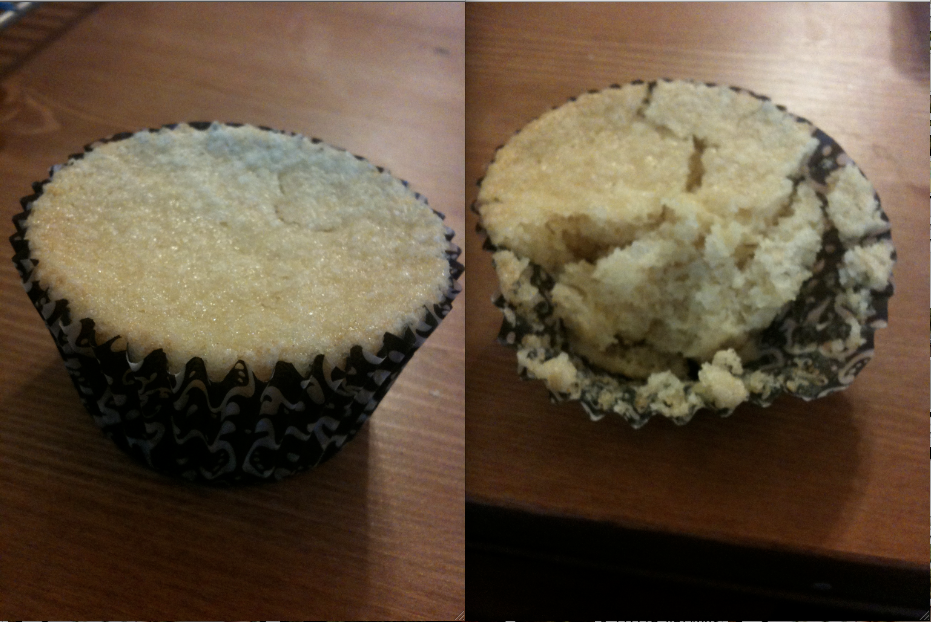High-Altitude Hummingbird Bakery Vanilla Cupcakes, Pt. 1: Adding More Flour
This is the first part of a three-step control group experiment attempting to get the Hummingbird Bakery’s vanilla cupcakes recipe to work in the high altitude environment of Denver.
Once again, sorry for the long silence. Work this week was especially brutal — I’ve been spending most days working 7am to 7pm, sitting in on meetings from 8am – 6pm. On the rare occasion I did actually leave work at 5.30, I did some insane working out (think handstand pushups, ring dips; or in my case, extremely modified versions of the excercises) at Crossfit LoDo and came home unable to lift my arms. Doesn’t really lend much time for baking experiments. On the plus side, I seem to be featured on my crazy gym’s website with increasing regularity, so at least I get some local fame out of this? Snort.
Anyway, so where did I leave off? Pre-Thanksgiving, I did my initial “control” experiment and followed the Hummingbird Bakery’s sea-level recipe for vanilla cupcakes to spectacular failure in Denver. The recipe’s use of generous amounts of baking powder caused the cupcakes to rise quickly and ultimately collapse into puddles of goop. I determined that I could do three things to adjust the recipe:
- Add flour, to strengthen the recipe’s batter and prevent it from collapsing into a puddle of goop during the cooling process.
- Decrease the amount of sugar, since sugar interferes with egg protein’s coagulation and requires more heat to set. Alternatively, I could just bake the cupcakes at a higher temperature.
- Decrease the amount of baking powder in the recipe, to slow down and decrease the batter’s rise.
Instead of try all alterations at once, I decided to isolate each adjustment so that I could see each change’s independent effect on the recipe. This week, I decided to add more flour to the batter.
Susan Purdy of Pie in the Sky: Successful Baking at High-Altitudes advises that, when experimenting, it is best to start with smaller adjustments and work up to larger ones if necessary. I followed this mantra and began by adding just one tablespoon of flour to the original Hummingbird Bakery recipe. My amendments to the original recipe are included in bold:
- 1 cup all-purpose flour + 1 tablespoon of all-purpose flour
- a “scant” 3/4 cup sugar
- 1 1/2 teaspoons baking powder
- a pinch of salt
- 3 tablespoons unsalted butter
- 1/2 cup whole milk
- 1 egg
- 1/4 tspn vanilla extract
This is what the cupcakes looked like when I pulled them out of the oven:
Not bad! Especially when compared to how they looked the first time I had tried the recipe without any adjustments. The flour seemed to have added the appropriate amount of strength to the cupcake’s batter. Sure, they didn’t look perfect — in fact, they looked flat-topped and sunken in. You know how perfectly cooked cupcakes have slightly domed top? Yeah, they definitely didn’t have that:
But I was perfectly happy with the results. So, I left the cupcakes to cool as I took a quick walk in the park. Unfortunately, I was definitely too optimistic because when I returned, I was greeted by this:
Oh no! The cupcakes had sunken in even further during my 15 minute walk in the park. They now resembled mini-craters instead of the flat-topped cupcakes I had expected:
Sigh. So they weren’t aesthetically pleasing. But how did they taste?
I tentatively pulled a cupcake out of one of the cake slats. It was a good sign that it held together — the first batch had simply been too goopy (resembling sticky puddles) that had made them impossible to even eat.
Hm. Okay. So the cupcake had actual cake-like texture, which was good. But it was way too sticky. The flavor was pretty decent. Almost a little too sweet, but that might have just been the stickiness contributing to the flavor. All in all, it wasn’t bad… just not good. Ha. And of course, nowhere comparable to the actual Hummingbird vanilla cupcake itself.
Sigh. But it’s a start, right?




